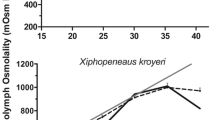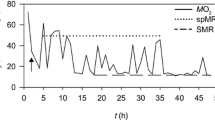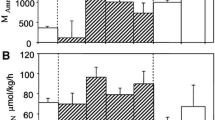Abstract
The respiratory and acid-base responses to hypoxia of the sea urchin Psammechinus miliaris Gmelin have been studied both in the laboratory and in the field. Sea urchins were collected from the Clyde Sea area, Scotland, between March and July 1993. Individual urchins were unable to regulate their oxygen uptake during hypoxia. The partial pressure of oxygen (PO 2) in the coelomic fluid was lower than ambient PO 2 during normoxia but still decreased with a decrease in environmental PO 2. There was a significant increase in pH and in the concentrations of bicarbonate, magnesium and calcium in the coelomic fluid, but a significant decrease in the partial pressure of carbon dioxide (PCO 2), in response to declining PO 2s. The disturbance of respiratory parameters in urchins accompanying hypoxic exposure in rock pools was similar to that observed in the laboratory, although not as severe as might have been expected on the basis of the laboratory experiments.
Similar content being viewed by others
References
Binyon J (1972) Physiology of echinoderms. Pergamon Press, Oxford.
Burnett L, Jorgensen D, Carroll A, Scholnick D, Terwilliger N (1990) Physiological responses of the purple sea urchin to air exposure. Am Zool 30: p. 62A
Cameron JN (1971) Rapid method for determination of total carbon dioxide in small blood samples. J appl Physiol 31: 632–634
Hiestand W (1940) Oxygen consumption of Thyone briareus (Holothuroidea) as a function of oxygen tension and hydrogen ion concentration of surrounding medium. Trans Wis Acad Sci Arts Lett 32: 167–174
Hill AD, Taylor AC, Strang RHC (1991) Physiological and metabolic responses of shore crab Carcinus maenas (L.) during environmental anoxia and subsequent recovery. J exp mar Biol Ecol 150: 31–50
Houlihan DF, Duthie G (1981) Measurement of oxygen consumption and sampling of body fluids of echinoderms in situ. J exp mar Biol Ecol 51: 97–106
Hyman LH (1929) The effect of oxygen tension on oxygen consumption in Planaria and some echinoderms. Physiol Zoöl 2: 505–534
Hyman LH (1955) The invertebrates. Vol. IV. Echinodermata. McGraw-Hill Inc., New York
Johansen K, Vadas RL (1967) Oxygen uptake and responses to respiratory stress in sea urchins. Biol Bull mar biol Lab, Woods Hole 132: 16–22
Koller G, Meyer H (1933) Versuche über die Atmung der Echinodermen (Asterias rubens und Echinus miliaris). Biol Zbl 53: 655–661
Lutz B (1930) The effect of low oxygen tension on the pulsations of the solated holothurian cloaca. Biol Bull mar biol Lab, Woods Hole 58: 74–84
Maloeuf NSR (1937) Studies on the respiration (and osmoregulation) of animals. I. Aquatic animals without oxygen transporter in their internal medium. Z vergl Physiol 25: 1–28
Morris S, Taylor AC (1983) Diurnal and seasonal variations in physicochemical conditions within intertidal rock pools. Estuar cstl, Shelf Sci 17: 339–355
Mortensen T (1927) Handbook of the echinoderms of the British Isles. Oxford University Press, Oxford
Newell RC, Courtney WAM (1965) Respiratory movements in Holothuria forskali. J exp Biol 42: 45–57
Nomura S (1926) Influence of oxygen tension on the rate of oxygen consumption in Caudina. Sci Rep Tôhoku Univ (Ser 4: Biol) 2: 133–138
Ryabushko VI, Zhuchikhina AA, Lutsik NV (1980) Effects of environmental oxygen concentrations on the level of metabolism in some echinoderms from the sea of Japan. Comp Biochem Physiol 67B: 171–174
Sisak MM, Sander F (1985) Respiratory behaviour of the western Atlantic holothuroidean (Echinodermata) Holothuria glaberrima (Selenka) at various salinities, temperatures and oxygen tensions. Com Biochem Physiol 80A: 25–29
Spicer JI, Taylor AC, Hill AD (1988) Acid-base status in the sea urchins Psammechinus miliaris and Echinus esculentus (Echinodermata: Echinoidea) during emersion. Mar Biol 99: 527–534
Taylor AC, Spicer JI (1991) Acid-base disturbances in the haemolymph of the prawns, Palaemon elegans (Rathke) and P. serratus (Pennant) (Crustacea: Decapoda) during exposure to hypoxia. Comp Biochem Physiol 98A: 445–452
Truchot J-P, Duhamel-Jouve A (1980) Oxygen and carbon dioxide in the marine environment: diurnal and tidal changes in rockpools. Respir Physiol 39: 241–254
Author information
Authors and Affiliations
Additional information
Communicated by J.P. Thorpe, Port Erin
Rights and permissions
About this article
Cite this article
Spicer, J.I. Oxygen and acid-base status of the sea urchin Psammechinus miliaris during environmental hypoxia. Marine Biology 124, 71–76 (1995). https://doi.org/10.1007/BF00349148
Received:
Accepted:
Issue Date:
DOI: https://doi.org/10.1007/BF00349148




